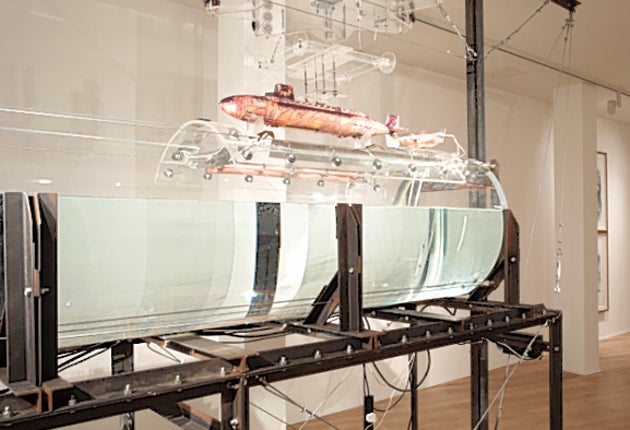Alexander Ponomarev: Sea Stories, Calvert 22, London

The Russian former nautical engineer, submariner and merchant seaman Alexander Ponomarev currently has his first major exhibition in London, at Calvert 22, and it's more than apparent that, though he may have left the sea behind as a profession, it is still at the centre of his very being. Sea Stories begins with an installation that is a complex piece of mechanical engineering (Ponomarev apparently required the assistance of two scientists from MIT to install it). A large clear cylinder of water runs the length of the gallery; the submarine that hangs above it is lowered into the water, and it adapts and changes as it moves along the tube, stealthy as a shark. To say more about what happens would ruin any surprise, suffice to say that Ponomarev is interested in the difference between what is on the surface and what lies beneath.
The sea, as much as it is one of the most immediate examples of the sublime and the unknowable in nature, and the setting for a song or a story or two, functions also for Ponomarev as a metaphor for human experience. We only understand the tip of the iceberg, as the saying goes, and reality runs far deeper. From Arthur Schopenhauer's writings all the way to the pop philosophy in movies such as The Matrix, there is a long history in the idea that reality is an illusion, or that we see only a fragment. The artist's concern with tearing the "veil" of reality can be seen in two videos documenting one of his major projects, named Maya: a Lost Island (2005). In the first, we see the artist erasing a small island named Sedioyatyl from a map, and in the second we see the Russian Navy actually trying, at the behest of the artist, to make the island disappear from view using smokescreens, and succeeding.
One comes away marvelling at the artist's powers of persuasion, also evident in the fact that the Russian military let him paint a submarine in anti-camouflage patterns and then sign his name with it in the sea. He was also allowed on to a scientific vessel to lower polystyrene cups with his portrait on them to the depths of the ocean – up to 4 kilometres deep – so that they shrank and distorted under pressure. Each cup is displayed, rather beautifully, in a Perspex box in the downstairs gallery suspended between the ceiling and the floor, and all of them seem to float in the room.
For all his complex performance videos involving the expertise and collaboration of many others, it really seems as though the places that Ponomarev gets his point across best are in his drawings and watercolours, many of which are on maps. There's something menacing about his monochrome drawings of the sea, that look as though they are from an apocalyptic graphic novel, and his drawings on maps seem to embody the sense of marine travel far better than the little camera snaps of the artist at work elsewhere in the space. He has some affecting art to make and some good stories to tell, but his central presence in the drawings and performances is a little too domineering to create the sense that they are stories that have truly been shared at this point. He obviously has an immense talent for realising wildly ambitious projects; he just needs to channel it into the right one.
To 21 November (www.calvert22.org)
Subscribe to Independent Premium to bookmark this article
Want to bookmark your favourite articles and stories to read or reference later? Start your Independent Premium subscription today.

Join our commenting forum
Join thought-provoking conversations, follow other Independent readers and see their replies